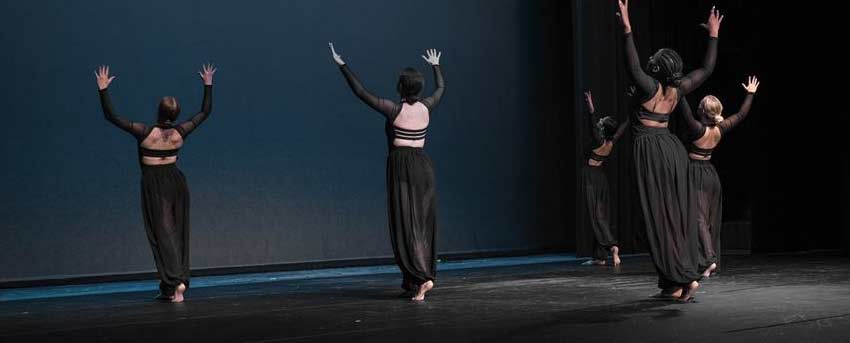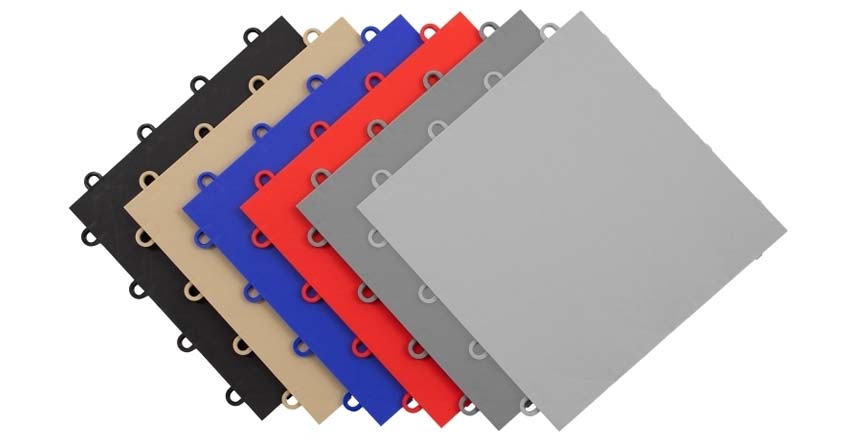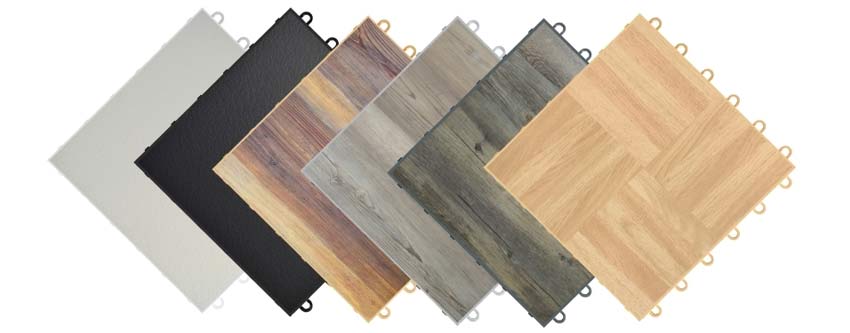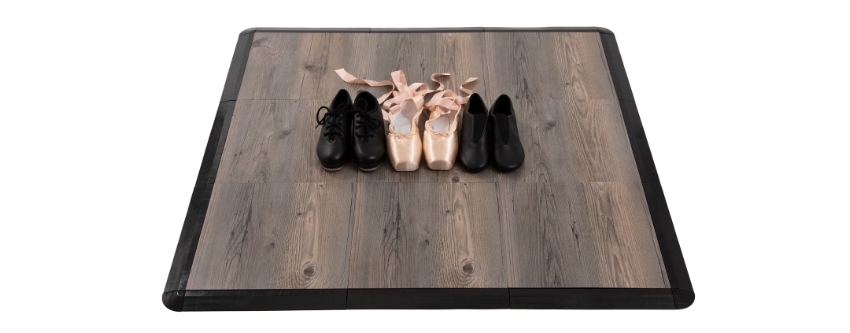Jazz Dance Flooring: Marley, Wood & More
Jazz is one of the most common styles offered at any dance studio. But what floor is best for jazz? With so much going on during a jazz dancer’s routine, the floor wouldn’t seem that important, but the floor is what supports the dancer through it all.
By learning the different considerations for dance flooring, and going over different flooring options, you can shop smart and warm up your jazz hands. Let’s go over the options to find the right jazz dance floor for your dancing shoes.
By learning the different considerations for dance flooring, and going over different flooring options, you can shop smart and warm up your jazz hands. Let’s go over the options to find the right jazz dance floor for your dancing shoes.
How to Choose Jazz Dance Flooring

Before you start shopping for your jazz dance flooring, it’s important to understand what makes a dance floor perfect for jazz. While most dance floors can handle all types of dance, there are a few considerations to keep in mind.
- Grip and slide: Jazz is one of the few styles where dancers often alternate between wearing jazz shoes and dancing barefoot. Therefore, the floor should have a certain level of slip-resistance and grip to help support those leaps, kicks, and other high-energy dance steps found in jazz.
- Sprung flooring: Sprung flooring is designed to absorb shock and ease bounce. Because jazz routines are usually high-intensity, a sprung floor will provide resiliency and support for every move which keeps the dancers safe from injury.
- Durability: Not all floors are meant to be danced on and no one wants to ruin a non-dance floor by practicing their routines. That’s why there’s dance flooring. For a floor to keep up and last, you’ll want to find a dance floor that is ready to stay strong for all the practices and performances.
- Installation process: Different types of floors require different installation processes that all depend on if you want a temporary or permanent dance floor. Before shopping, decide what kind of installation you want and your comfort level with the process.
- Size: All jazz routines are meant to feel larger than life. Whether it’s a solo or group routine, you need a dance floor that can fit all dancers and all routines with no issue.
Types of Jazz Dance Floors
When dancing jazz you need optimal slip-resistance and grip, as jazz choreography often alternates between wearing jazz shoes and dancing barefoot. Luckily, there are different styles of jazz dance flooring to choose from. With your choice of dance tiles, Marley rolls, dance floor kits, and subfloor tiles, you can find the perfect flooring so your dance troupe will always be on beat.


Marley Floors for Jazz
What a lot of people don’t know is the name “Marley” was originally a dance floor brand. In reality, there are no true Marley floors around anymore. The dance community just kept the name. Now, “Marley” is the name for any variation of rolled vinyl dance flooring.
There are so many versions of Marley on the market today, and most of them are recommended and great for jazz. These floors should have the perfect amount of grip, slide, absorption, and resilience to support your kicks, leaps, and more.
There are so many versions of Marley on the market today, and most of them are recommended and great for jazz. These floors should have the perfect amount of grip, slide, absorption, and resilience to support your kicks, leaps, and more.
Top-rated Marley Dance Floors
Let’s get your shopping adventure off to the right start. Check out our customer-favorite Marley jazz dance floors.
Jazz Dance Floor Tiles
If you’re looking for a dance floor that is more temporary or portable, leap onto dance tiles instead. Dance tiles are made of hard plastic or vinyl and are super easy to install wherever you go. Plus, these tiles are available in a variety of colors, wood looks, and stone looks, so your dance floor will look great and be ready for all the tricks.
These tiles also support you with optimal grip and slide, whether you dance barefoot or in jazz shoes. No matter if you’re spinning or leaping, your floors have your back.
These tiles also support you with optimal grip and slide, whether you dance barefoot or in jazz shoes. No matter if you’re spinning or leaping, your floors have your back.
Top-rated Jazz Dance Floor Tiles
Narrow your shopping list by taking a look at our most popular jazz dance tiles.
Portable Jazz Dance Floor Kits
If you want to practice your jazz moves on the go, enjoy an ultra-portable jazz dance floor kit to support you at home, in the studio, or on the road for a competition.
These dance floor kits are easily installed and taken apart in no time, so you can enjoy a convenient dance space wherever you go. Be it jazz, tap, or hip-hop our portable dance kits are there to support you and your dancing dreams!
Portable jazz dance floor kits come in multiple sizes to fit your needs and space. They also come in wood looks and a variety of colors, so you can find a floor that matches your style.
These dance floor kits are easily installed and taken apart in no time, so you can enjoy a convenient dance space wherever you go. Be it jazz, tap, or hip-hop our portable dance kits are there to support you and your dancing dreams!
Portable jazz dance floor kits come in multiple sizes to fit your needs and space. They also come in wood looks and a variety of colors, so you can find a floor that matches your style.
Top-rated Portable Jazz Dance Floor Kits
To find the perfect portable dance floor, consider our customer favorites to help your search.
- Practice Dance Tile Kits
- VersaStep Dance Floor Package with Subfloor
- ProStep Dance Floor Package with Subfloor
Dance Subfloors
When installing a dance floor, it’s important to consider the support underneath the floor. Whether you’re a studio, school, or professional company, the last thing you want is injured dancers. And the best way to prevent injuries is to start with a dance subfloor. A subfloor is a sprung floor that absorbs and distributes the dancer’s weight, which allows them to jump, leap, and roll with a lower risk of injury. To install a subfloor, all you need is a clean, flat, level surface.
Subfloors come in tile and roll form so no matter your flooring, your subfloor is covered. Luckily, we also have a great selection of subfloors to choose from.
Subfloors come in tile and roll form so no matter your flooring, your subfloor is covered. Luckily, we also have a great selection of subfloors to choose from.
Top-Rated Dance Subfloors
There are so many subfloors to choose from, right? Let us help with our most popular dance subfloor options.
How to Install Jazz Dance Flooring
When it comes to installation, each dance flooring option is a little different. This also depends on whether you are doing a permanent, semi-permanent or temporary installation.
For a basic understanding of installing both dance rolls and dance tiles, let’s go over some instructions.
For a basic understanding of installing both dance rolls and dance tiles, let’s go over some instructions.

How to Install Marley Tap Dance Flooring Rolls
Installing dance rolls is pretty simple. The instructions just differ a little between temporary and permanent dance roll installation. Check it out.Temporary Installation
- After unrolling the floor, allow it 1-2 days to relax and lay flat, keeping the shiny side down, matte side up.
- To make any cuts to the rolls, use a straight edge and a utility knife. Be sure to leave a 1/4″ gap around the rolls to account for expansion and contraction from temperature changes.
- Using double-sided carpet tape on the underside of each roll, outline the perimeters, and firmly press the edges to the floor, ensuring there are no ripples.
- If you’re installing over foam subfloor tiles and you have excess around the edges, tape this perimeter down to your main floor using mat tape, creating a ramp or tapered installation. If you’re installing over foam tiles and there isn’t extra around the edges, tape down the perimeter of the roll directly to the subfloor tiles using mat tape.
- Use mat tape on top of the flooring to join the seams of multiple rolls together.
Permanent Installation
When it comes to the permanent dance flooring, there are a few more steps to take to make sure that the floor stays put. This process requires glue to ensure excellent adhesion to the subfloor.- Spread out the rolls and allow them to relax for 1-2 days until they lay completely flat. Make sure the shiny side faces down, with the matte side up, as the top is textured to provide a better grip while dancing.
- Use a straight edge and a utility knife to cut the rolls to fit, and leave a 1/4″ gap to account for expansion and contraction.
- Roll up the flooring at one end of the room. Spread a light layer of adhesive in 10’ increments or shorter depending on your comfort. Then gradually unroll the flooring into the adhesive.
- Continue this step for every 10’ of the roll until you’re finished.
- To push out any air bubble and to ensure good adherence, use a 100-pound roller on the floor. Walking on the flooring in small choppy steps may also work if you can’t find a roller.

How to Install Jazz Dance Flooring Tiles
Dance floor tiles are even easier to install than rolls. The edges interlock with a snap, kind of like giant puzzle pieces. You can do it on your own in a day. Plus, you can easily pull them up and transport them if you need to.Let’s get started.
- Start at the top left corner of the dance area. Place the first tile with the peg edges facing towards the top and left. Make sure the loops face the bottom and right.
- Insert the pegs of the second tile into the loops of the first. Step on the edge of the tiles gently to snap them together.
- Repeat this step until you finish one full side of your dance floor.
- For the second row, interlock the top of your second-row tile with the bottom of your first-row tile.
- Continue the same process to fill in all of your rows of tiles to create your full dance floor size.
- Add any finishing edge pieces once the tiles are in place. These will either have loop or peg edges. Start with the peg edges, and lay them out to be sure you have enough before clicking them into place.
- As you did with the peg edges, count out all of the loop edges to make sure you have enough. Once you are ready you can click the loop edges into place to complete your floor.
How to Maintain Jazz Dance Flooring
Finding a dance floor that is easy to maintain is not as challenging as you might think. Most dance floors are easy to clean and maintain as long as you keep up with a cleaning routine.
Loose dirt and dust can grind into your floors causing visible damage, so the less loose dirt, the better. The best way to keep the outside dirt away from your beautiful dance floor is to sweep or vacuum your floor after every use.
Once the floors are dirt-free, use a damp mop with a mild cleaning solution to take care of any stuck-on dirt or spots. Also, make sure to clean up spills right away, and you’ll be good to go!
Loose dirt and dust can grind into your floors causing visible damage, so the less loose dirt, the better. The best way to keep the outside dirt away from your beautiful dance floor is to sweep or vacuum your floor after every use.
Once the floors are dirt-free, use a damp mop with a mild cleaning solution to take care of any stuck-on dirt or spots. Also, make sure to clean up spills right away, and you’ll be good to go!
Conclusion
From rolls to tiles to kits, there are so many jazz dance floors for sale. Now that you have an idea of what you’re looking for, are you ready to find the right floor for you?




